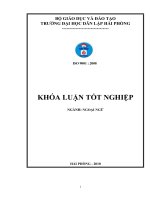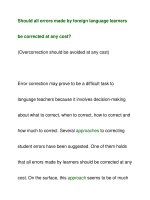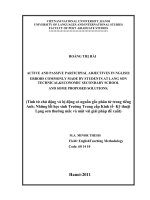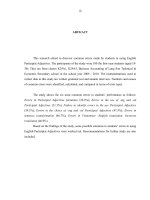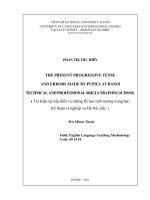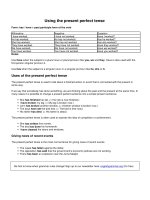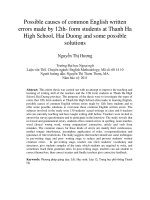The present progressive tense and errors made by pupils at Hanoi Technicaland professional skills training school
Bạn đang xem bản rút gọn của tài liệu. Xem và tải ngay bản đầy đủ của tài liệu tại đây (226.62 KB, 13 trang )
The present progressive tense and errors made b
y pupils at Hanoi Technicaland professional skil
ls training school
Phan Thị Thu Hiền
University of Languages and International Studies
M.A Thesis English teaching methodolody, Code: 60 14 10
Supervisor : M.A. Phung Thi Kim Dung
Year of graduation: 2011
Abstract: Through the researcher‟s observations, although the Present
Progressive tense is a common tense, pupils still make a lot of errors.
However, there have been very few studies on these errors. Therefore, this
research has been carried out to investigate common errors on forms and
uses of the Present Progressive tense plus some distinctions with the
Present Simple tense. The subjects of the study were 50 pupils of the first
year who were studying English at the school. The research was based on a
grammar test consisting of three questions in the design of multiple-choice
items. Using a simple descriptive statistical procedure, the researcher has
found out the percentages of common errors on forms, uses, and
distinctions with Present Simple these subjects made. Based on the
findings, recommendations for teaching the Present Progressive tense have
been offered.
Keywords: Tiếng Anh; Phương pháp giảng dạy; Ngữ pháp
Content
Part A: Introduction
1. Rationale
English is increasingly becoming an important language in the world nowadays.
Its significance is reflected in the fact that almost everyone learns it in order to
communicate with people from a different country. Actually, English is being recognized
as a means of global communication.
As a part of the integrated world, Vietnam is trying to improve its English
language education in many parts of the country from urban to rural, and even
mountainous areas. Teachers as main agents in the classroom can investigate existing
serious problems, carry out research, and seek solutions to these problems to eradicate
them from the classroom. In this way, they will contribute to the overall improvement of
the quality of English language teaching and learning in their schools in particular, and in
Vietnam in general. This study has been done based on this background.
For my school, Hanoi technical and professional skills training school, English is
still considered a minor subject, and the pupils‟ general level of English is rather limited.
Here, teaching English mainly focuses on grammar, which occupies most of teachers and
pupils‟ study time and takes the considerable percentage in tests and exams.
Nevertheless, the result of this investment is not much optimistic.
Although the Present Progressive tense is a common tense which is often taught
carefully, pupils still make quite a lot of errors in terms of form and use. For example,
instead of speaking or writing He is studying English, these pupils produced sentences
like He studying English or He is studing English, etc. In addition, not few of them have
difficulty in distinguishing between this tense and the Present Simple tense, so they often
make errors such as I live with my friends right now. This is mostly evident through their
practice and test results, as observed by the researcher before this study was carried out.
In this circumstance, although documents on the Present Progressive tense are
available, most of them are not full and detailed. Besides, errors on this tense are rarely
mentioned except for in the Master thesis of Pham Viet Huong (2003) named The
English present tenses in comparison and contrast with Vietnamese equivalent
expressions. In her study, common errors and solutions are given but in such a general
way. In addition, studies conducted at vocational schools are rather spare.
For the above mentioned reasons, the study entitled The Present Progressive tense
and errors made by pupils at Hanoi technical and professional skills training school
has been carried out.
2. Aims of the study
This writing provides knowledge of the Present Progressive tense fully and
systematically as the theoretical framework to investigate common errors made by pupils
at Hanoi technical and professional skills training school, through which offers
recommendations for teaching the tense.
3. Scope of the study
This study is limited to the investigating of written errors which are common on
the forms and uses of the Present Progressive tense plus some distinctions with the
Present Simple tense. The study is carried out on 50 pupils of the first year who are
studying English at school.
4. Methodology of the study
First of all, information about the Present Progressive tense in reliable websites
and prestigious books was collected, analyzed and synthesized in the literature review.
Next, in the study, the quantitative technique ( a multiple-choice test ) was employed.
Besides, a simple descriptive statistics was applied in the data analysis procedure.
5. Significance of the study
This writing offers a full and detailed look at the Present Progressive tense as both
the studying and teaching materials. Besides, common errors mentioned in the study are
really helpful especially to non-experienced teachers. More importantly,
recommendations given are not useful only to this tense but other tenses as well. Finally,
this study provides an overview of teaching and learning at a vocational school as
inspirations to following studies on this subject.
Part B: Development
Chapter 1 - Literature review
In this chapter, knowledge of the Present Progressive tense, also called the Present
Continuous tense is provided fully and systematically as the theoretical framework for the
investigations of common errors in the following chapter. Besides, as Present Progressive
(PP) is sometimes mistaken with Present Simple (PS), some comparisons between two
tenses are also mentioned. However, before coming to the main part about PP, a brief
discussion about time – tense - aspect relationship is necessary.
1.1. Time - tense - aspect relationship
(Source:
1.2. present progressive tense
1.2.1. Forms
a) To be
b) Present participle
(Source:
c) Structures
The Present Progressive tense is formed with present tense of auxiliary “be” and
present participle.
am/ is/ are + V-ing
Positive structure
S+
am/ is/ are
+V-ing.
‟m/ ‟s/ ‟re
Negative structure
We add the word not after Am/ Is/ Are to form the Negative.
S+
am/ is/ are + not
+V-ing.
‟m/ ‟s/ ‟re + not
isn‟t/ aren‟t
Interrogative structure
We invert Am/ Is/ Are before “S” to form the Interrogative.
Yes/ No questions:
Am/ Is/ Are + S + V-ing?
- Yes, S + am/ is/ are.
- No, S + am/ is/ are + not.
The contraction is not included in the structure above.
WH- questions:
We add question words like who, whom, what, which, where, when, why, how, etc
at the beginning of the question.
WH- + am/ is/ are + S + V-ing?
Negative – interrogative structure
( WH- ) +
am/ is/ are + S + not
+ V-ing?
isn‟t/ aren‟t + S
Note: We use contractions in informal situations.
1.2.2. Uses
In English, the Present Progressive tense is usually used to express continuing or
ongoing actions which are taking place at the moment of speaking or writing. Specific
uses are mentioned below.
a) Firstly, we use it for things that are happening at the moment of speaking.
b) We can also use this tense for temporary situations, when we feel something will not
continue for a long time.
c) We can use the present continuous tense to describe habits which are temporary or
new.
d) Another present continuous use is for describing annoying habits, when we want to
show that something happens too often and we do not like it. In this case we need to use
an adverb like „always‟, „forever‟, „constantly‟.
e) The next use is for describing definite future arrangements (with a future time word).
In this case we have already made a plan and we are pretty sure that the event will happen
in the future.
f) Finally, we use this tense to talk about a situation which is changing slowly.
(Source: />continuous-use.html)
1.2.3. Signal words
Signal words used with the PP tense are divided into two groups.
a) Signal words describing actions happening now
now, right now, just now, for now, for a little while, at the moment, at present,
presently (= now)
After imperative
While + present situations
b) Signal words describing actions in the future.
today, tonight, this week/ month/ year/ summer, etc.
tomorrow, next week, etc.
These signal words are quite useful in identifying the PP tense. However,
“Tagging the adverbs and the expressions which use the present continuous can also be
counter-productive. Many languages rely entirely on adverbs to express that an action is
temporary, and it is a problem for many learners to get used to verb form (i.e. continuous
aspect) to express this in English.” (Parrott, 1999: 159)
1.2.4. Stative and Dynamic verbs
a) In English language, there are verbs that are not normally used in Progressive tenses,
because they describe states rather than actions. They are called stative verbs, including:
b) The verbs that can be used in Progressive tenses are called dynamic verbs, including:
c) Some verbs can be both stative and dynamic verbs depending on their meanings.
1.3. Present Progressive tense vs. Present Simple tense
Because the PP tense is sometimes mistaken with the PS, some comparisons
between two tenses are discussed here. Nevertheless, first of all an overview of the PS
tense may be useful.
( Source:
Now, let us compare the PS with PP tense, mainly to point out differences between
the two tenses.
a) Forms
b) Uses
c) Signal words
d) Stative and Dynamic verbs
(Source:
Besides, detailed differences on uses can be found in Eastwood (2005: 38-53).
Chapter 2 - THE STUDY
In the previous chapter, knowledge of Present Progressive tense is provided fully
and systematically. It is the theoretical framework for investigations of common errors on
forms and uses of the PP tense made by pupils at Hanoi technical and professional skills
training school (Hatechs). Subsequently, recommendations for teaching the tense are
offered in this chapter.
2.1. Context of the study
2.1.1. Teachers
2.1.2. Pupils
2.2. Research questions
Focusing on the understanding of the Present Progressive tense of pupils at
Hatechs, this paper seeks to obtain data that answer the following research questions:
1. To what extent do pupils at Hatechs make errors on forms and uses of the Present
Progressive tense?
2. To what extent can pupils at Hatechs distinguish Present Progressive tense with
Present Simple tense?
Answers for these questions can be obtained through detailed discussion on errors
made by pupils in the area of the Present Progressive tense.
2.3. Subjects
The population of the study was about 403 first - year pupils of Hatechs. Through
systematic sampling, 50 pupils were chosen.
More than three-fourths of the subjects scored the average marks (from 5 to 7) in
the Exam 1 of English, so the results can reflect the general performance of all. Since
these pupils were in moderate proficiency categories, it could be assumed that the degree
of diversity was reasonably low and that a sample of data elicited from 50 subjects would
be sufficient. Prior to collecting the sample, the researcher was aware that certain
variables, particularly previous training in the language and intelligence quotients, might
have affected their performance on the grammar test. However, this study did not aim at
investigating the correlation between their performance on a grammar test and other
possible independent variables such as proficiency levels or intelligence quotients.
2.4. Data collection Instrument
According to Bachman (1990: 68), “Language tests can also be used in research”
and “Responses to language tests can provide a rich body of data for the identification of
processing errors and their explanation”. Consequently, this study was based on a
grammar test consisting of three questions aiming at investigating pupils‟ errors on the
Present Progressive. The questions in the design of multiple-choice items were useful in
measuring the subjects‟ errors on forms and uses, and on distinctions between PP and PS.
The test was administered to the subjects after they had learnt the lessons about PP
and comparisons between PP and PS.
2.5. Data analysis procedure
In this study, a simple descriptive statistical procedure was used when considering
the data in terms of percentages of subjects' errors which were grouped into types. Then
these percentages were compared with those in items testing the same problems in order
to identify the average percentage of each error type made by the subjects. Besides,
possible causes were also pointed out as explanation for their errors.
2.6. Results and Discussion
2.6.1. Question 1
Table 1. The result for Question 1 in terms of percentages of the subjects‟ choices.
Choice Item
A
B
C
D
1.
8
16
46
30
2.
10
14
20
56
3.
18
54
12
16
4.
16
6
26
52
5.
8
14
58
20
6.
20
62
14
4
From the table above, detailed discussion is made to make out the percentages of
the subjects making the same types of errors and their possible causes. In order to make
comparisons, items testing the same problems are paired as follows:
2.6.2. Question 2
Table 2. The result for Question 2 in terms of percentages of the subjects‟ choices.
Choice
Item
A
B
C
D
1.
28
8
48
16
2.
38
46
6
6
3.
14
6
4
76
4.
82
8
6
4
5.
36
46
6
8
6.
86
6
2
6
7.
32
8
44
16
8.
10
8
6
74
From the table above, detailed discussion is made to make out the
percentages of the subjects choosing the wrong uses and their possible causes. In order to
make comparisons, items testing the same uses are paired as followed.
2.6.3. Question 3
Table 3. The result for Question 3 in terms of percentages of the subjects‟ choice of
Present Progressive.
Verb
Item
1
2
1.
10
86
2.
4
66
3.
70
20
4.
76
22
5.
22
62
6.
18
78
7.
70
6
8.
12
80
From the table above, detailed discussion is made to work out the percentages of
the subjects choosing PP and their possible causes. In order to make comparisons, items
testing the same matters are paired as followed
2.7. Summary and RECOMMENDATIONS
2.7.1. Summary
In all, the findings of the study can be summarized as follows:
- To research question 1:
On forms: about one-third of the subjects made errors with the formation of
present participle; one-fifth with the inversion of auxiliary, and about one-fourth made
errors like the omission of Be or –Ing, the misuse of Not, or the mistake with PS tense
respectively.
On uses: around half of the subjects had difficulty with the use of PP tense to
express either actions happening around the time of speaking or changing situations. The
use of PP for definite future arrangements was the problem of around one-fourth of all.
Only one-fifth had difficulty with the use of PP to express actions happening at the time
of speaking.
- To research question 2:
On distinctions with PS tense: the imperative or the exclamatory sentence was not
helpful to one-fifth in choosing the PP tense; frequency adverb together with PP seemed
strange to one-third of all; still one-third did not realize stative verbs used with action
meanings, and one-fourth were unaware of differences between PP and PS for future
activities.
2.7.2. Recommendations
The identification of errors helps teachers be aware of the errors commonly made
by their learners so that teachers can pay more attention to problematic aspects of the PP
tense. As an aid to their teaching of the tense, this following part proposes some
recommendations with the hope to enhance the quality of learning.
a) Forms
To Be
Present participle
b) Uses
c) Distinctions with the PS tense
Moreover, teachers can find specific practice on the distinctions in Bourke (1999:
81-87).
Finally, a variety of interesting exercises on the PP tense can be found in
Ryazanova and Simolina (1983: 28-57) and Swan & Walter (2001: 21-30) as the teaching
materials. In addition, simple and effective procedures to present and fun video tasks to
practise the PP tense are introduced as reference materials in the Appendix 3 and 4
respectively.
Part c: conclusion
At first, in chapter 1, knowledge of the Present Progressive tense, including forms,
uses, signal words, stative and dynamic verbs as well as comparisons with Present Simple
tense is provided in a detailed and systematical way.
Next, in the chapter about pupils‟ errors, common errors made by pupils at Hanoi
technical and professional skills training school are investigated and identified as follows:
On forms: about one-third of the subjects made errors with the formation of
present participle; one-fifth with the inversion of auxiliary, and about one-fourth made
errors like the omission of Be or –Ing, the misuse of Not, or the mistake with PS tense
respectively .
On uses: around half of the subjects had difficulty with the use of PP tense to
express either actions happening around the time of speaking or changing situations. The
use of PP for definite future arrangements was the problem of around one-fourth of all.
Only one-fifth had problems with the use of PP to express actions happening at the time
of speaking.
On distinctions with PS tense: the imperative or the exclamatory sentence was not
helpful to one-fifth in choosing the PP; frequency adverbs together with PP seemed
strange to one-third of all; still one-third did not realize state verbs used with action
meanings, and one-fourth were unaware of differences between PP and PS for future
activities.
Finally, to overcome difficulties mentioned, recommendations for teaching the
Present Progressive tense: its forms, uses and distinctions with Present Simple tense are
in turns offered.
Hopefully, the above information will be of great help to not only teachers of
English but also to all those concerning the topic.
However, due to time, ability and experience limitations, this study may have
some short-comings and the researcher would highly appreciate any suggestions and
modification.
Last but not least, the pragmatics of the Present Progressive tense as well as the
cross linguistics aspect of learners‟ errors might be interesting suggestions for further
research.
References
Books:
1. Bachman L. F. (1990), Fundamental considerations in language testing, OUP,
England.
2. Biber D. (1999), Longman grammar of spoken and written English, Longman,
England.
3. Bourke K. (1999), The grammar lab - Book one, Oxford, NY.
4. Eastwood J. (2005), Oxford learner's grammar : grammar builder, Oxford, NY.
5. Korsakov A. (1969), The use of tense in English : The structure of modern
English-part 1, Lvov University, Lvov.
6. Parrott M. (1999), Grammar for English language teachers : with exercises and a
key, CUP, Cambridge.
7. Pham Viet Huong (2003), The English present tenses in comparison and contrast
with Vietnamese equivalent expressions, VNU-CFL, Hanoi.
8. Ryazanova N.K. & Simolina M.V. (1983), Time and tense, Prosveshenje, M.
9. Quirk R. & Greenbaum S. (1972), A Grammar of Contemporary English,
Longman, England.
10. Quirk R. & Greenbaum S. (1993), A University Grammar of English, Longman,
England.
11. Swan M. & Walter C. (2001), The good grammar book : with answers, Oxford,
NY.
12. Turton N.D. & Heaton J.B. (1996), Longman dictionary of common errors,
Longman, England.
Websites:
13.
14.
15.
16.
17.
18. />m
19.
20. />to-practise-present-simple-and-present-continuous.286.html
21.
22.
23.


